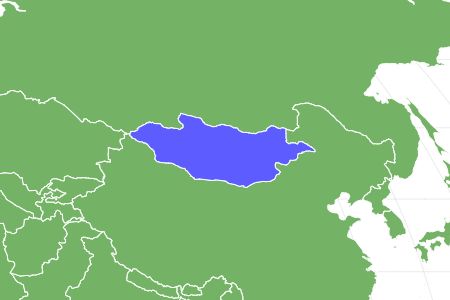The camel with two humps!
Advertisement
Bactrian Camel Scientific Classification
- Kingdom
- Animalia
- Phylum
- Chordata
- Class
- Mammalia
- Order
- Artiodactyla
- Family
- Camelidae
- Genus
- Camelus
- Scientific Name
- Camelus Bactrianus
Read our Complete Guide to Classification of Animals.
Bactrian Camel Conservation Status
Bactrian Camel Facts
- Main Prey
- Seeds, Grass, Thorny Shrubs
- Distinctive Feature
- Thick fur and two humps
- Habitat
- Deserts close to water
- Predators
- Human, Tiger, Monitor Lizards
- Diet
- Herbivore
View all of the Bactrian Camel images!
The double-humped, wild Bactrian camel is one of the least-studied animals in the world and in danger of extinction!
Double-humped camels are called Bactrian camels. Two species roam the planet today: domesticated Bactrian camels and wild Bactrian camels. Unfortunately, wild Bactrians are teetering on the verge of extinction and also rank among the least-studied animals on Earth. If drastic measures aren’t implemented soon, they could cease to exist in 20 years. Conversely, domesticated Bactrian camels are thriving and boast population numbers in the millions. The one-humped dromedary camels are also plentiful.
Ten Fascinating Bactrian Camel Facts
- Recent genetic studies revealed that domesticated Bactrian camels are a different species than the wild ones. They are thought to have diverged 1.1 million years ago.
- People in what is now Afghanistan and Turkestan began domesticating Bactrian camels in 2500 B.C.
- Wild Bactrians are the only remaining wild camel species in the world.
- In ancient Arabian times, riding camels was a status symbol.
- Bactrian camels can carry 170 to 250 kilograms (370 to 559 pounds) for 47 kilometers (30 miles) a day.
- In 1856, the United States military initiated the Camel Corps. But, the Civil War broke out, so the government abandoned the project.
- Mongolians hold a yearly camel race. Participants wear traditional clothing, and colorful commentators give play-by-play updates of the nine-mile race over bullhorns.
- Camel dung is so dry it can be used to fuel fire without first being dried out.
- Camels don’t sweat until their body temperature reaches 106 degrees Fahrenheit.
- The ancient Greek philosopher Aristotle first described camels in his book “History of Animals.”
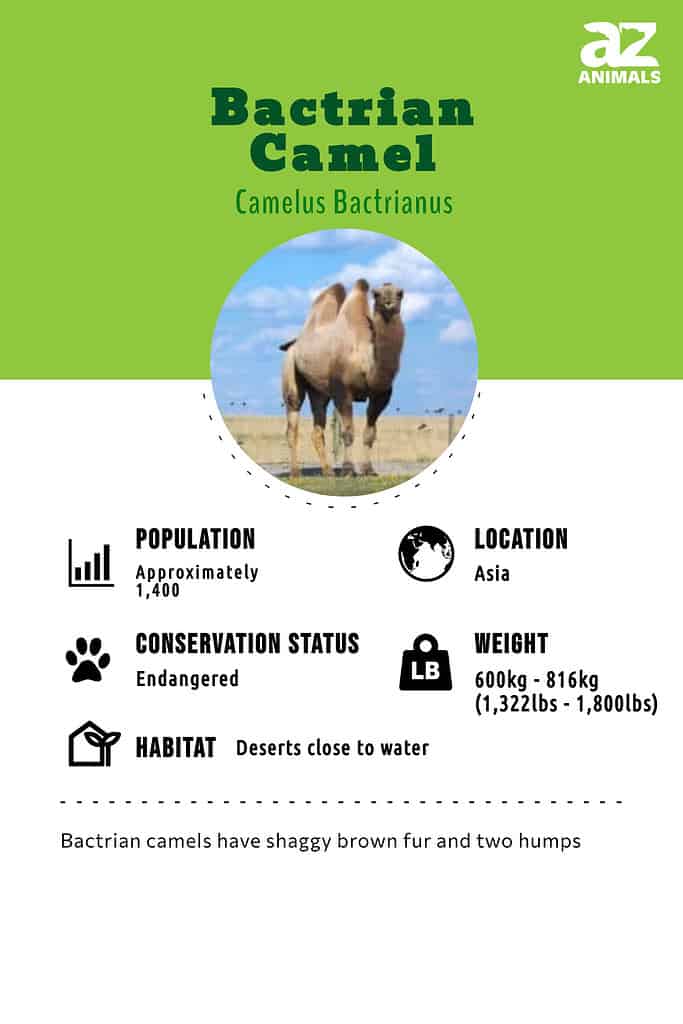
Scientific Name
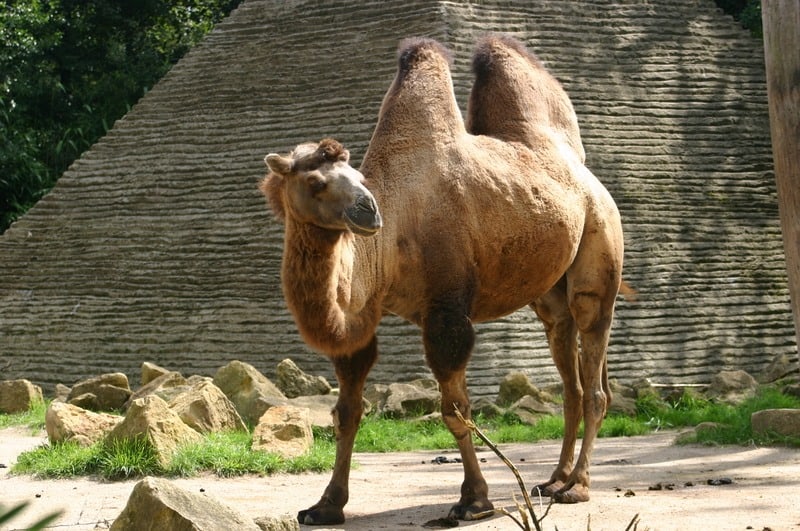
Bactrian Camels may be wild or domesticated
©EmmanuelFAIVRE assumed (based on copyright claims), CC BY-SA 2.5, via Wikimedia Commons – License
Camelus ferus is the scientific name for wild Bactrian camels, and Camelus Bactrianus is the scientific name for domesticated Bactrian camels.
Camelus comes from Latin. Linguists believe the word evolved from the Arabic phrase jamala, which means “to bear.” Bactrian, and by extension Bactrianus, refer to an ancient region in Asia called Bactria. Ferus references “feral,” which means wild.
The Mongolian word for wild Bactrians is havtagai.
Types
- The domestic Bactrian camel (Camel bactrianus): By far more numerous compared to their wild relatives – their population is about 2 million – these mammals have a woollier coat which occurs in a wide range of colors and bulkier humps. However, they lack the ability to process salty water as efficiently as their wild cousins.
- The wild Bactrian camel (Camel ferus): In spite of a similar appearance, these mammals are somewhat different from their domesticated relatives genetically speaking since they actually descended from a different set of forbears. Their coats are generally less luxuriant compared to domestic Bactrian camels’, their heads are also flatter, and their humps smaller. They are also capable of processing water with high levels of salinity efficiently.
Evolution and Classification
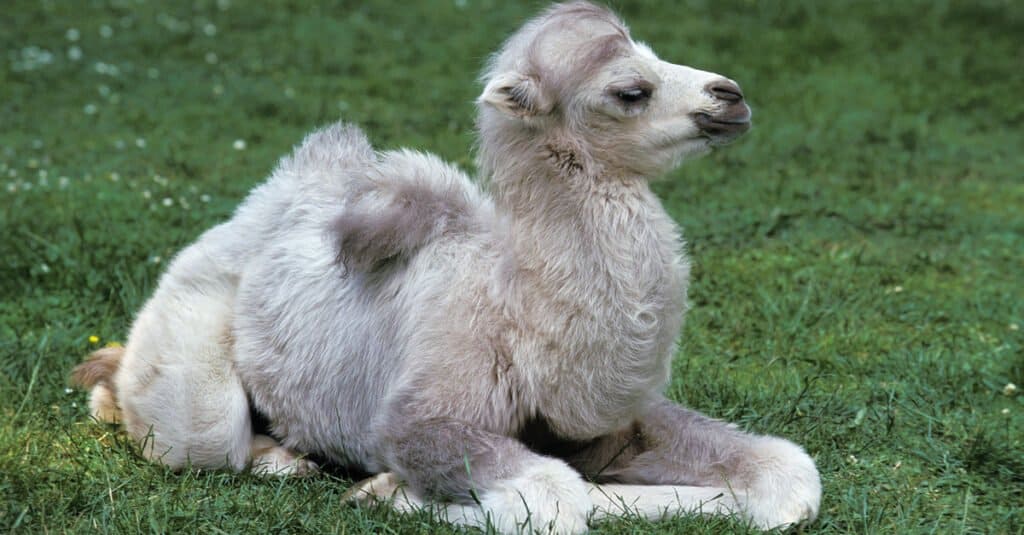
Early camelids were far smaller than their present-day descendants
©slowmotiongli/Shutterstock.com
Both wild and domesticated Bactrian camels belong to the family Camelidae. As a result, they are not only related to Dromedaries, their cousins with single humps, but also alpacas, llamas, guanacos, and vicuñas.
The story of this rather small family dates all the way back to several creatures including one known as Protylopus. Far from having the comparatively large sizes of its present-day descendants, this four-toed mammal was the size of a rabbit and lived in an area corresponding to present-day North America during the mid-Eocene (between 40 – 50 million years ago).
Leaping 10 – 15 million years forward, during the Late Eocene, the earth was now home to larger goat-sized camelids such as the two-toed Poebrotherium.
The ancestors of present-day camelids only got to leave North America approximately 3 million years ago. A number of them moved southward following the formation of the Isthmus of Panama. Others moved into Asia.
In time only the Bactrian and the Dromedary, and their smaller distant South American relatives remained.
Appearance and Behavior

Bactrian Camels have an excellent sense of smell in spite of their small-sized nostrils
©The original uploader was Head at German Wikipedia, Public domain, via Wikimedia Commons – License
Camel bodies are built to withstand extreme conditions, and they can survive in temperatures ranging from 20 degrees Fahrenheit (-29C) to 120 degrees Fahrenheit (49C). Learn about the toughest animals in the world here.
Appearance
Many people think camel humps are water containers, but their signature bumps are actually stuffed with fat that can be accessed in lean times. When the fat is drained, the humps don’t maintain their shape. Instead, they flip-flop from side to side.
Bactrian camel heads are rectangular, but wild Bactrian skulls are flatter. Their noses are muscular narrow slits that can be closed to block dirt and sand. However, despite their tiny nostrils, camels have an excellent sense of smell.
Their small hairy ears and double-row of eyelashes also guard against the elements. A set of hidden eyelids, with two halves that shut like windows, also serve as an extra seal. Plus, their bushy eyebrows act as natural sun visors. Bactrian camels even have hair on their lips to protect against thorny shrubs.
Domesticated Bactrians sport thick, shaggy fur, and they rock large beards on their throats and necks. However, wild coats are thinner. They come in a range of colors, from dark brown to eggshell white. Molting happens naturally, and the fur tends to come off in large clumps, which gives the camels a ragged appearance in spring months.
Camel feet are one of Mother Nature’s technological marvels. They have round hooves with two large toes that carry weight evenly. A tough outer membrane protects against hot and rocky terrain, and built-in shock absorbers ease the pain of long treks.
Bactrian camels are between 225 to 350 centimeters (7.38 to 11.48 feet) long. From the top of their humps to the ground, they’re about 213 centimeters (6.9 feet) tall and usually tip the scales between 300 and 1,000 kilograms (660 to 2,200 pounds). They are the largest camel species, the largest mammal in their native range, and males are typically larger than females.
Humps on wild Bactrian camels are smaller and more cone-shaped than the ones on domesticated Bactrians. Moreover, domesticated individuals have shorter legs and smoother fur. But both species have powerful muscles that help the animals stay upright when strong winds blow through.
Behavior
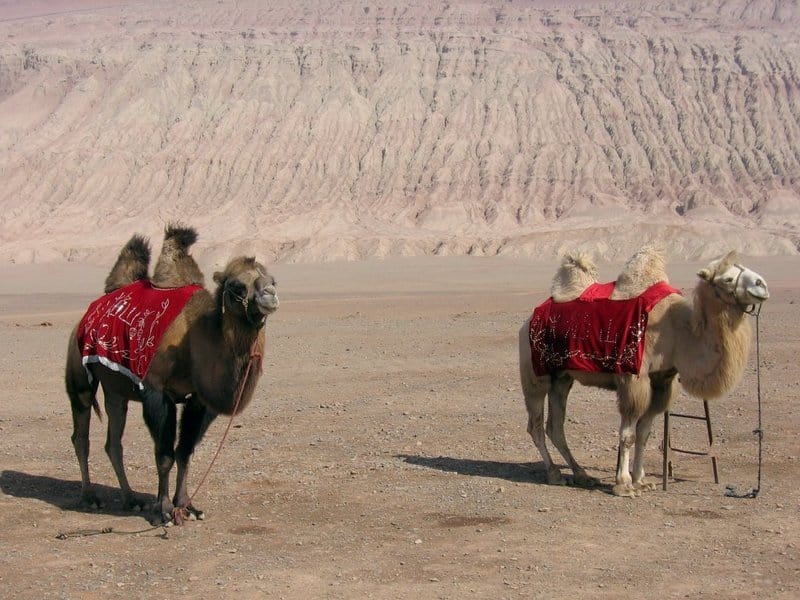
Bactrian camels are diurnal, which means they sleep at night and forage for food during the day. They travel in packs called flocks or caravans. Up to 30 animals may roll together with a single male leading the way, but it’s more common to see packs of 6 to 20. After a rain, the different flocks convene at rivers, springs, and other water sources to load up, and a single animal can drink up to 57 liters of water in one sitting. That’s like drinking an entire beer keg at once!
Domesticated Bactrian camels are warm, friendly animals that form affectionate bonds with humans. Mothers and children are also exceptionally close, and when death strikes, they mourn for up to six months. Wild Bactrians, on the other hand, are shier. They usually run away when people come close and can scatter quickly! Though camels may appear lumbering, the animals can sprint up to 65 kilometers (40 miles) per hour! Watch out, though, if you find yourself close to a camel. Like their alpaca and llama cousins, Bactrian camels spit. But what comes out of their mouth isn’t saliva — it’s vomit!
Not only are camels fine-tuned for harsh ground conditions, but they’re also excellent swimmers.
Habitat
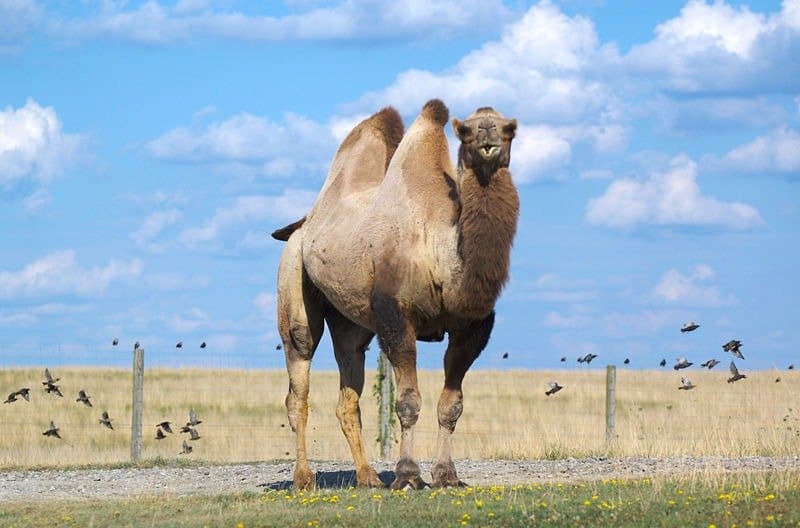
Bactrian Camels can be found in the Gobi desert but mainly live in sanctuaries
©Jeff Kubina from Columbia, Maryland, United States., CC BY-SA 2.0, via Wikimedia Commons – License
Wild Bactrian camels are native to arid regions in central Asia. Specifically, they stick to the Gobi Desert of northern China and southern Mongolia. Currently, the overwhelming majority live on conservation preserves, including:
- Lop Nur Wild Camel National Nature Reserve
- Great Gobi: A Strictly Protected Area
- Altun Shan Wild Camel Nature Preserve
- Aksai Annanba Nature Reserve
- Dunhuang Wanya Idun Nature Reserve
The Lop Nur reserve was once a nuclear testing site, but it hasn’t affected the camels. However, recent mining activity in the area is proving deleterious. As such, scientists are working with officials to relocate the camels to Pleistocene Park in Siberia. The Bactrians would be a proxy for another camel species that went extinct in the region. If the plan works, the move could be a boon for the species.
Regarding the move to Siberia, you may be wondering, “can camels live in cold and snowy regions?” The answer is yes! Camels are highly adaptable. They can withstand scorching temperatures, frigid conditions, and everything in between.
Domesticated Bactrians live throughout Asia on farms and with families.
Diet
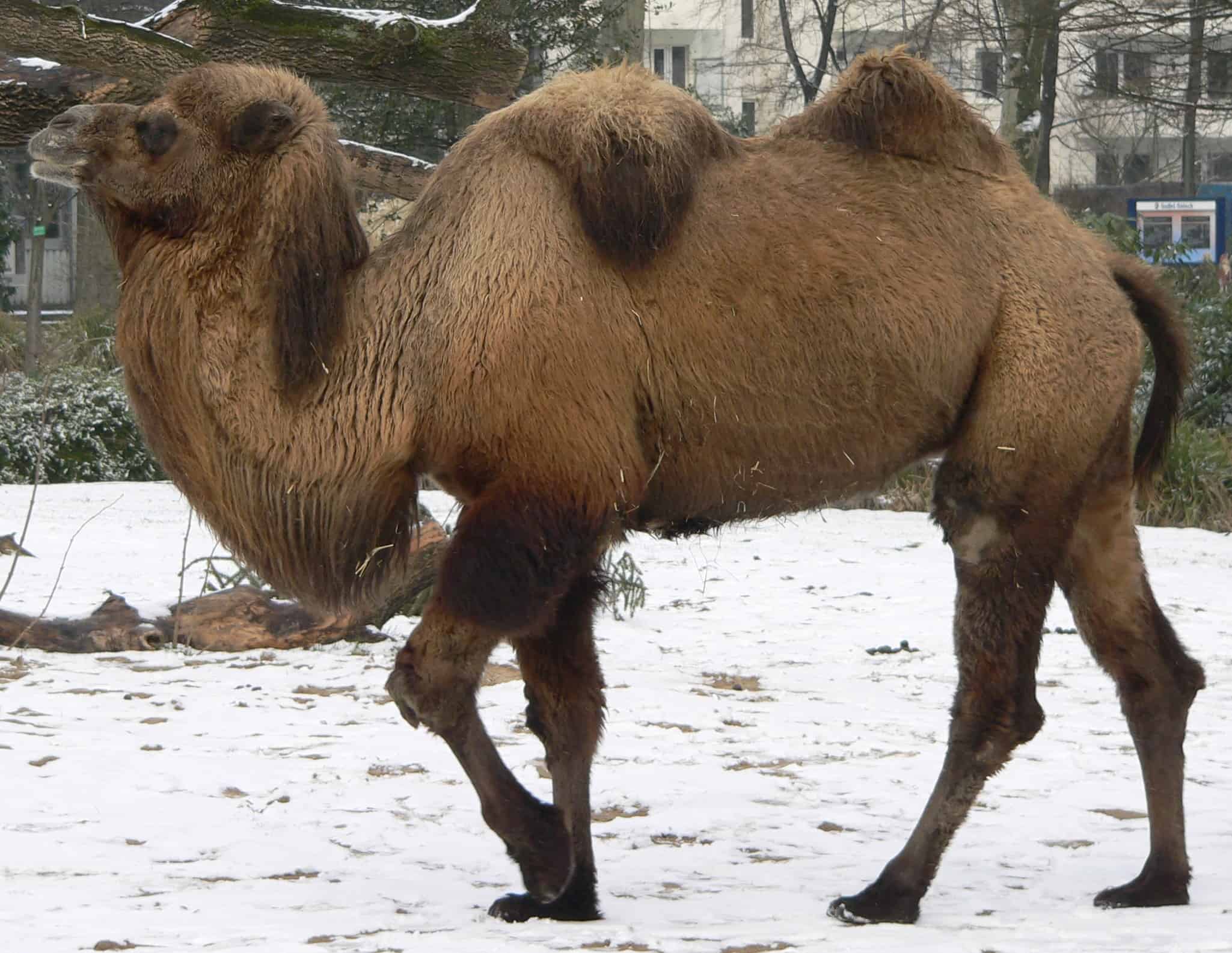
Bactrian Camels are omnivores and are capable of deriving nutrients from tents and footwear if the need arises
©de: Benutzer:BS Thurner Hof, CC BY-SA 3.0, via Wikimedia Commons – License
Bactrian camels are omnivores in every sense of the word. While they prefer to dine on shrubs — including feather grass, tamarind trees, and saxaul trees — they will down whatever they can find. Camels won’t kill other land animals, but they will eat carcasses and suck the marrow from bones. They’ll also kill fish. If no meat or vegetation is available, camels have special enzymes that can digest tents, clothes, and shoes.
Wild Bactrians can handle saltwater better than any other animal; however, domesticated ones aren’t as hardy. Both can extract nutrients from snow and ice though, which is a natural skill that many animals don’t have. Bactrian camels can also draw water from plants and bark.
Speaking of water, camels can down over 100 liters (22 gallons) in under 10 minutes! That’s the equivalent of drinking 300 glasses of water in 10 minutes! Because of their ability to consume so much at once, camels can go for weeks between feedings.
Predators and Threats

Gray wolves are the only wild animals which hunt Bactrian camels
©Holly S Cannon/Shutterstock.com
Gray wolves are wild camels’ only natural predators. Caspian tigers once preyed on them, but they’ve since gone extinct regionally. Today, humans are the species’ worst threat.
Humans started hunting Bactrian camels for their meat and hides in the 1800s. By the 1920s, the population had significantly dwindled. Officials established poaching restrictions; however, illegal hunting remains a problem. Moreover, as humans encroach on camel territory, the situation has worsened. Farmers shoot camels that get too close to livestock, and some even use land mines to protect their properties.
Rezoning is also devastating for Bactrian camels in the wild. In China, mining toxicity is proving especially harmful.
Domesticated Bactrian camels aren’t in the same danger as wild ones. However, some scientists worry that elevated rates of hybridization between domestic and wild Bactrians could lead to genetic degradation and further harm the wild population.
Reproduction, Babies, and Lifespan
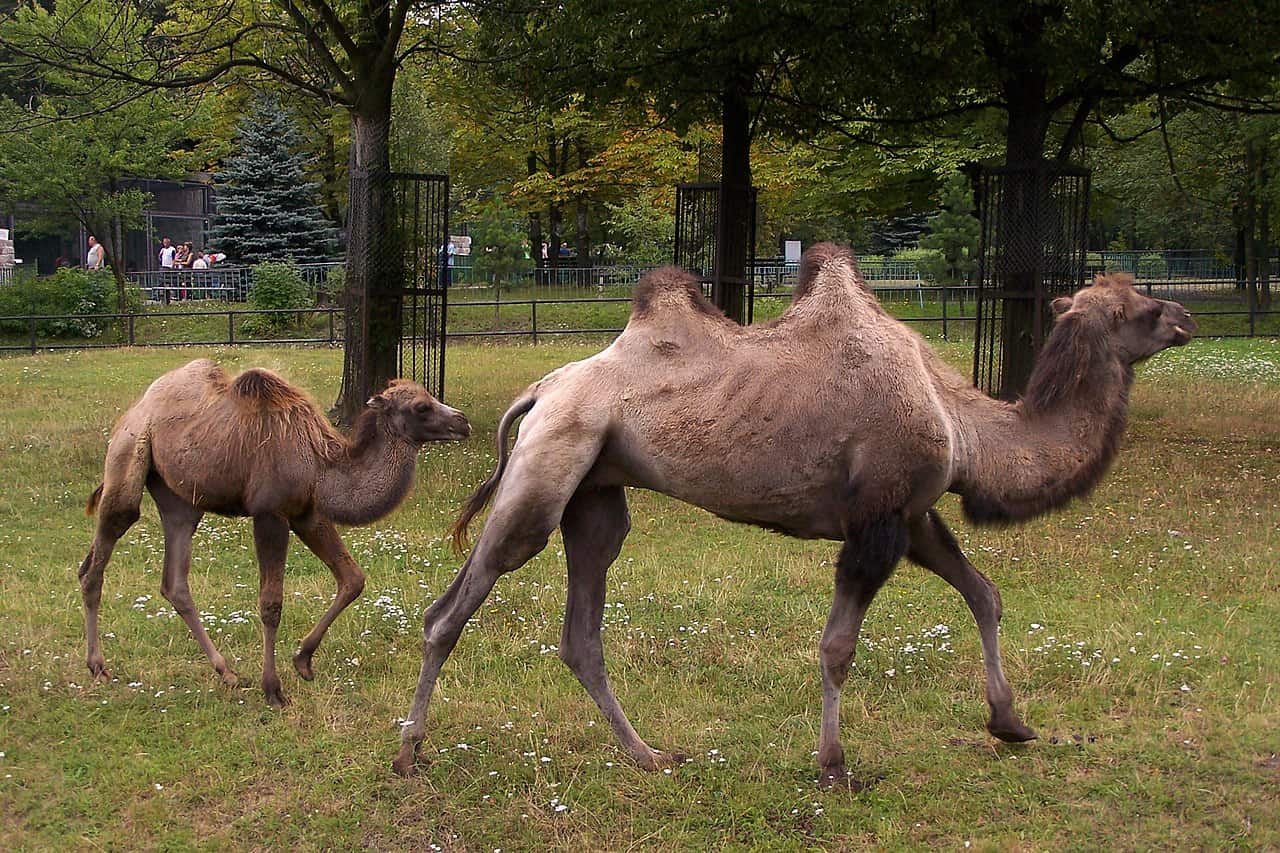
Bactrian camels have a gestation period of 13 months
©Lestat (Jan Mehlich), CC BY-SA 3.0, via Wikimedia Commons – License
Since wild Bactrians are endangered, several conservation mating programs are underway.
Reproduction
Winter is mating season for Bactrian camels. To attract females, males vocalize and strike awkward poses.
Lady camels reach sexual maturity at around five years old and are induced ovulators, meaning they don’t release eggs until they’ve been inseminated.
Gestation lasts 13 months, and they typically give birth every other year. Mothers usually give birth to one baby at a time, but twins happen on rare occasions.
If you see a lone camel straggling, it’s likely just reached puberty and searching for a flock to join.
Young
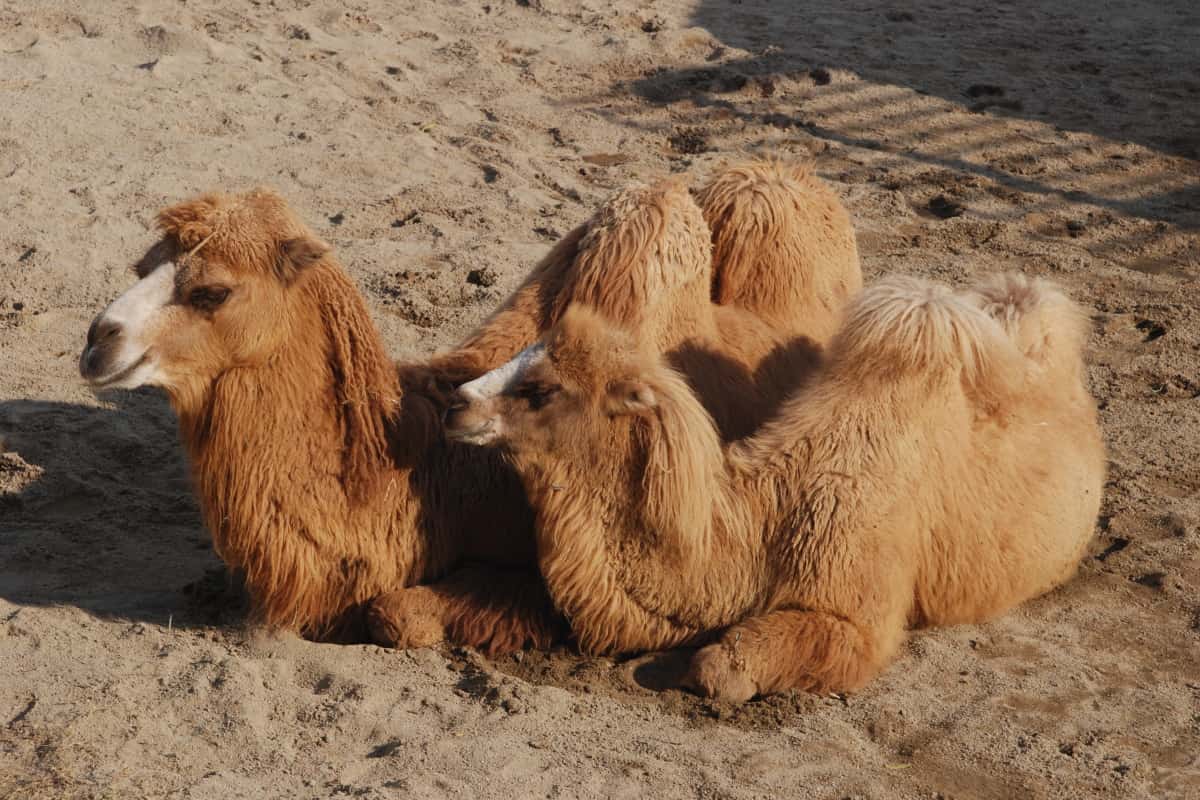
Bactrian Camel
©Kuribo, CC BY-SA 3.0, via Wikimedia Commons – License
A baby Bactrian camel is called a calf, and males are sometimes referred to as bull calves. They don’t have humps when born and weigh about 36 kilograms (79 pounds) at birth. Lightening fast learners, camels are precocial – meaning they can walk within hours of entering the world.
Calves stay with their mothers for three to four years, and they nurse for about one and a half of those. Helpful and involved siblings, they often help raise new babies that come during that time.
Moms and their offspring form strong bonds, and they mourn each other’s deaths for up to six months.
Lifespan
Camels typically live between 40 and 50 years.
Although it can’t be confirmed, in 2014, Nogeyama Zoo in Japan reported that one of its camels lived to 120, making it the oldest camel ever.
Population
The International Union for the Conservation of Nature Red List ranks wild Bactrian camels as Critically Endangered. Researchers estimate that only 1,400 remain. The Zoological Society of London lists the animals as the eighth most-endangered large mammal in the world.
However, domesticated Bactrian camels are in much better shape. About two million of them live throughout Asia, and hybridization efforts are big business in places like Kazakhstan.
Bactrian Camel FAQs (Frequently Asked Questions)
Are Bactrian camels carnivores, herbivores, or omnivores?
Bactrian camels are omnivores. They prefer to eat shrubs, but in a pinch will consume whatever is around, including meat, fish, and fabric.
How do farmers and families use domesticated Bactrian camels?
Selling camel wool is a big source of income for Mongolians. They also use camels as pack animals to transport goods and supplies.
What are the three species of camel?
Three camel species currently walk the planet. They include:
- Dromedary camels
- Domesticated Bactrian camels
- Wild Bactrian camels
Dromedary camels have one hump, and Bactrian camels have two.
Why do Bactrian camels have two humps?
Bactrian camels have two humps that store fat. The animals access it in times of famine and convert the fat into nutrients, energy, and water.
What Kingdom do Bactrian Camels belong to?
Bactrian Camels belong to the Kingdom Animalia.
What phylum do Bactrian Camels belong to?
Bactrian Camels belong to the phylum Chordata.
What class do Bactrian Camels belong to?
Bactrian Camels belong to the class Mammalia.
What family do Bactrian Camels belong to?
Bactrian Camels belong to the family Camelidae.
What order do Bactrian Camels belong to?
Bactrian Camels belong to the order Artiodactyla.
What genus do Bactrian Camels belong to?
Bactrian Camels belong to the genus Camelus.
What type of covering do Bactrian Camels have?
Bactrian Camels are covered in Fur.
In what type of habitat do Bactrian Camels live?
Bactrian Camels live in deserts close to water.
What are some distinguishing features of Bactrian Camels?
Bactrian Camels have thick fur and two humps.
What do Bactrian Camels eat?
Bactrian Camels eat seeds, grass, and thorny shrubs.
What are some predators of Bactrian Camels?
Predators of Bactrian Camels include humans, tigers, and monitor lizards.
What is the average litter size for a Bactrian Camel?
The average litter size for a Bactrian Camel is 1.
What is an interesting fact about Bactrian Camels?
The Bactrian camel has two humps!
What is the scientific name for the Bactrian Camel?
The scientific name for the Bactrian Camel is Camelus Bactrianus.
What is the lifespan of a Bactrian Camel?
Bactrian Camels can live for 35 to 50 years.
How fast is a Bactrian Camel?
A Bactrian Camel can travel at speeds of up to 40 miles per hour.
How to say Bactrian Camel in ...
Thank you for reading! Have some feedback for us? Contact the AZ Animals editorial team.
Sources
- David Burnie, Dorling Kindersley (2011) Animal, The Definitive Visual Guide To The World's Wildlife
- Tom Jackson, Lorenz Books (2007) The World Encyclopedia Of Animals
- David Burnie, Kingfisher (2011) The Kingfisher Animal Encyclopedia
- Richard Mackay, University of California Press (2009) The Atlas Of Endangered Species
- David Burnie, Dorling Kindersley (2008) Illustrated Encyclopedia Of Animals
- Dorling Kindersley (2006) Dorling Kindersley Encyclopedia Of Animals
- David W. Macdonald, Oxford University Press (2010) The Encyclopedia Of Mammals

